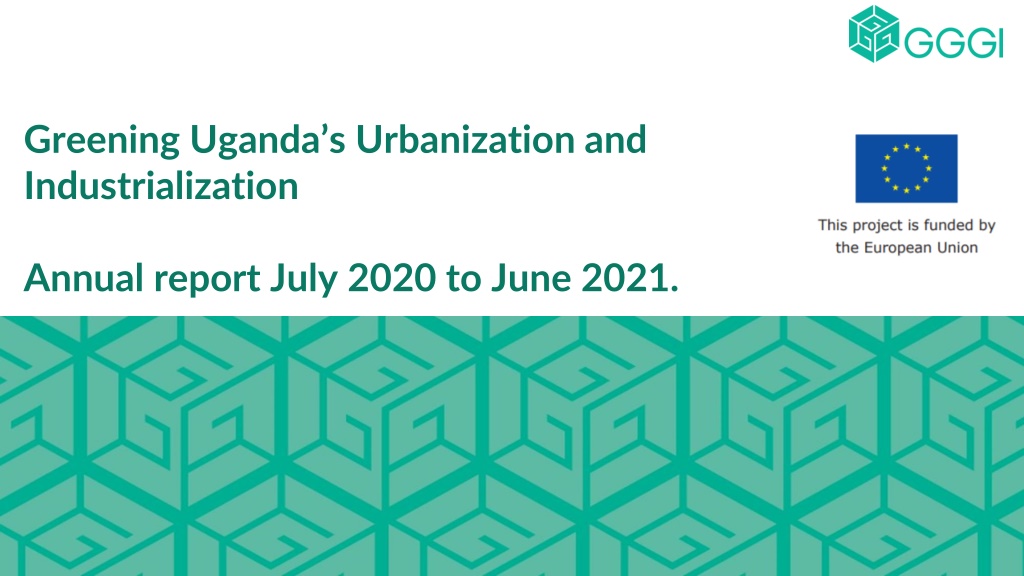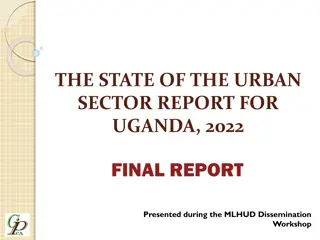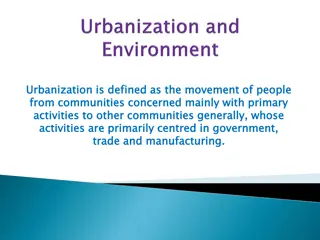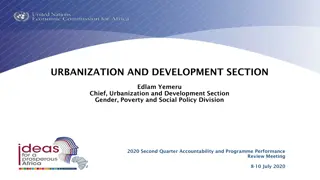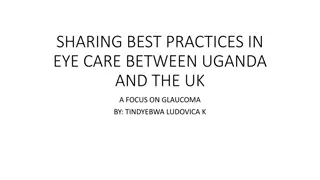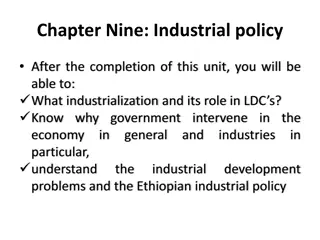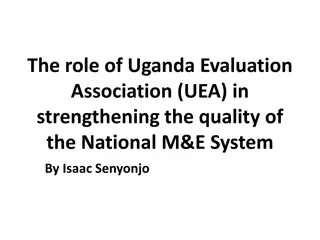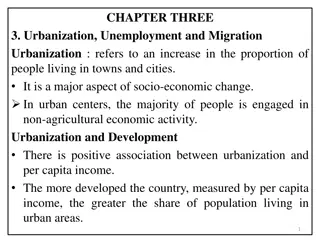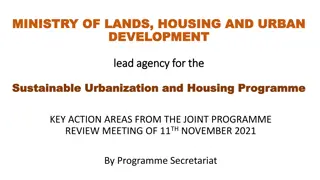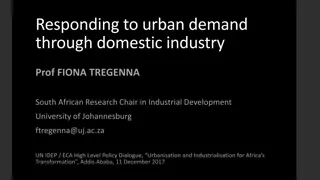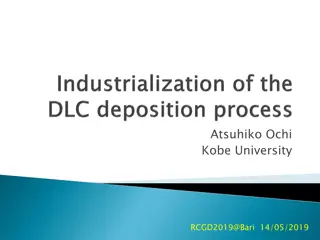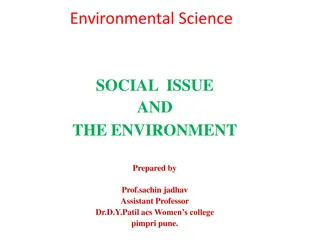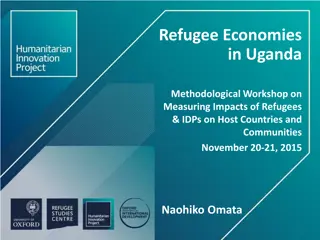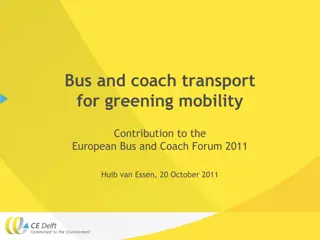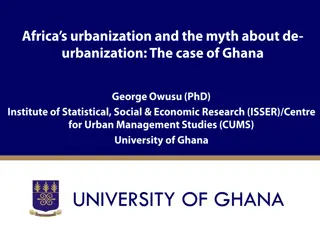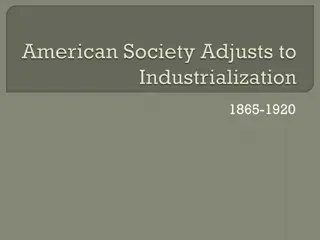Greening Uganda's Urbanization and Industrialization Report 2020-2021
Report highlights Greening Uganda's efforts towards sustainable urbanization and industrialization through various outcomes and outputs. It showcases initiatives like Green City Development, Green Industrialization, Efficient Waste Management, and integration of Green Growth in National Development Planning. The team involved, project outcomes, and focus on implementation for performance improvement are discussed.
Uploaded on Oct 05, 2024 | 1 Views
Download Presentation

Please find below an Image/Link to download the presentation.
The content on the website is provided AS IS for your information and personal use only. It may not be sold, licensed, or shared on other websites without obtaining consent from the author. Download presentation by click this link. If you encounter any issues during the download, it is possible that the publisher has removed the file from their server.
E N D
Presentation Transcript
Greening Ugandas Urbanization and Industrialization Annual report July 2020 to June 2021.
GGGIs Mission To help developing country governments transition towards a model of economic growth that is environmentally sustainable and socially inclusive.
The team and deliverables The team and deliverables The work is being delivered by a small team: Ron (project lead), George (urban), Regina (industrial), Philip (financing), Mariah (administration), Vanessa (communications) and Dagmar (50% - CR). Outcome 1: Green City Development is pursued and demonstrated in four Secondary Cities. Outcome 2: Green Industrialization is pursued and demonstrated at four locations. Outcome 3: Efficient and effective waste management is pursued and demonstrated. Outcome 4: Green Growth integrated into the NDP s planning and budgeting.
Project outcomes and outputs Greening Uganda s Urbanization and Industrialisation Outcome 1: Green City Development is pursued and developed in four (4) secondary cities Output 1.1 The National Building Code incorporates green building standards Output 1.2 Green Growth is mainstreamed in the Masterplans for four Secondary Cities Output 1.3 Infrastructure Investment Plans for four (4) Secondary Cities are finalised Output 1.4 A knowledge and engagement platform established by Makerere University Outcome 2: Green Industrialisation is pursued and demonstrated at four (4) locations Output 2.1 National Green Industrial Parks (IBP) and Free Zones (FZ) policy guidelines are finalised Output 2.2 National Low-Carbon Industrialisation Strategy 2020-2040 is finalised Output 2.3 Green Growth is mainstreamed in the Masterplans for four (4) selected IBPs and/or FZs Output 2.4 Infrastructure Investment Plans for four (4) IBP and/or FZ is finalised, including Emission Reduction potentials Outcome 3: Efficient and effective waste management is pursued and demonstrated Output 3.1 GKMA Waste Management Strategy Developed Output 3.2 Two waste sorting and diversion centres designed for the GKMA Output 3.3 Organic Waste Valorisation Opportunities identified including Fecal Sludge Value Chain Solutions in Urban Centres Output 3.4 Investment opportunities for oil/petroleum waste and e-waste products identified Output 3.5 Business Development Support for waste management value chain actors/SMEs is provided. Outcome 4: Green Growth is integrated into the National Development Plan's planning and budgeting Output 4.1 The Uganda Green Growth Development Strategy (UGGDS) communication strategy implemented Output 4.2 A "Green Growth integration and tracking in planning and budgeting" checklist developed Support tasks Activity 5.1 Project management Activity 5.2 Project communication and dissemination Activity 5.3 South-South Knowledge Exchange GOAL:
Focus on implementation for performance Focus on implementation for performance Results (important in themselves) cannot be reported if implementation the delivery of outputs is not achieved first. Thus, an implementation measurement framework has been introduced. RfP (5) and responses (5) or other offical responses T=10 Evaluation done (5), decision issued (5) or other agreement to proceed T=10 Contract signed or other agreement in place (5), start date agreed (5) T=10 ToR (5) EoI (5) or other official text to start T=10 Start of work T=10 Reached half-way T=20 Accepted / handed over (10) Completed T=20
Actual scores Actual scores As of 31 December, EU s Q4- 2020 36 % Now! change +12 implementation score was 48 Outcome 1: Urbanisation 21 percent. The score is now 32 52 +20 Outcome 2: Industrialisation 33 percent. There is strong 1 20 +19 Outcome 3: Waste management Outcome 4: NDP green implementation movement on Urbanisation 1 9 +8 and Industrialisation. Waste 33 37 +2 Project management management is now moving. The slowest is Outcome 4. 21 33 +12 Averages
1. Urban management thinking The November 2020 s mission s purpose was, in a learning-by-doing format, to introduce technical personnel and local political leaders in the four cities to: The Urban Score Card; The concept of blue and green open spaces; Each council s revenue profile; and The level of official consents for building development. 2. City councils as local development agencies as engines of growth the new LG leaders briefing in May City councils are the principal driver to their city s development. City councils retain the holistic perspective of their cities. Spending MDAs should be encouraged to heed the spatial and reinforcing trunk infrastructure needs of cities.
Development challenges! Some startling data from local government participants during that November 2020 mission through the lens of the Urban Score Card suggested the following: Water under 50 percent provision; Solid waste management (SWM) under 30 percent official SWM; Informal housing around 50 percent of total urban housing stock; Electricity around 50 percent of total need supplied; Construction less than 50 percent of building work is officially approved.
Conclusion Year 1 ended in June 2021. By December end, we will have only 18 months left. Next big milestones include: Physical development plan (PDPs) for the extensive annexed areas of Arua and Gulu, master plans and infrastructure investment plans for all four cities (including Mabara and Jinja) and all four industrial locations (Gulu, Soroti, Pakwach and Entebbe). Industrial master plan and supporting policy framework (by April). a SWM master plan (and more) for the GKMA, also by April. Frankly, we re only scratching at the surface of what is needed to green Uganda s urbanization and industrialization!
Thank You Ronald McGill Project Lead ronald.mcgill@gggi.org 0779 561 051 Follow our Activities on Facebook and Twitter www.gggi.org
